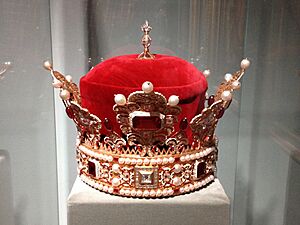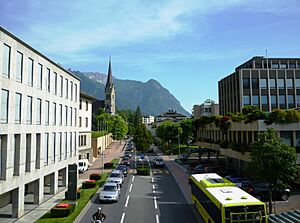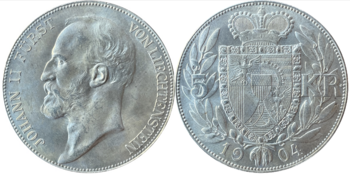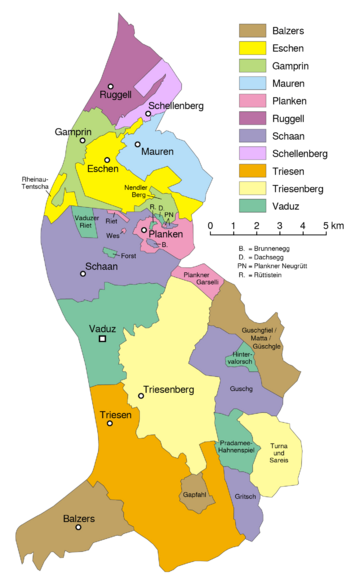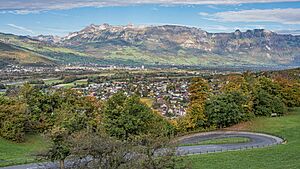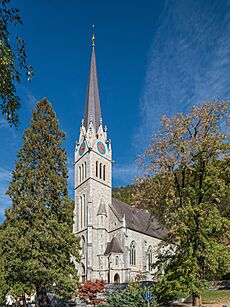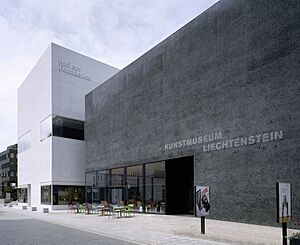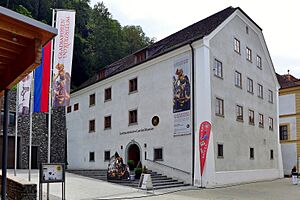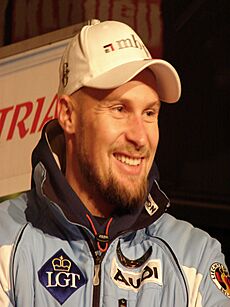Liechtenstein facts for kids
Quick facts for kids
Principality of Liechtenstein
Fürstentum Liechtenstein (German)
|
|
|---|---|
|
Motto: "Für Gott, Fürst und Vaterland"
"For God, Prince and Fatherland" |
|
|
Anthem:
(English: "High on the Young Rhine") |
|
![Location of Liechtenstein (green)on the European continent (agate grey) — [Legend]](/images/thumb/2/23/Europe-Liechtenstein.svg/350px-Europe-Liechtenstein.svg.png)
Location of Liechtenstein (green)
on the European continent (agate grey) — [Legend] |
|
 |
|
| Capital | Vaduz |
| Largest municipality | Schaan 47°10′00″N 9°30′35″E / 47.16667°N 9.50972°E |
| Official languages | German |
| Ethnic groups
(2017)
|
|
| Religion
(2020)
|
|
| Demonym(s) | Liechtensteiner |
| Government | Unitary parliamentary semi-constitutional monarchy with elements of a direct democracy |
|
• Monarch
|
Hans-Adam II |
|
• Regent
|
Alois |
| Daniel Risch | |
| Legislature | Landtag |
| Independence as principality | |
|
• Union between
Vaduz and Schellenberg |
23 January 1719 |
| 12 July 1806 | |
|
• Separation from
German Confederation |
23 August 1866 |
| Area | |
|
• Total
|
160.50 km2 (61.97 sq mi) (190th) |
|
• Water (%)
|
2.7 |
| Population | |
|
• 2023 estimate
|
|
|
• Density
|
249/km2 (644.9/sq mi) (56th) |
| GDP (PPP) | 2014 estimate |
|
• Total
|
$4.978 billion (176th) |
|
• Per capita
|
$98,432 |
| GDP (nominal) | 2022 estimate |
|
• Total
|
|
|
• Per capita
|
|
| HDI (2022) | very high · 12th |
| Currency | Swiss franc (CHF) |
| Time zone | UTC+01:00 (CET) |
|
• Summer (DST)
|
UTC+02:00 (CEST) |
| Driving side | right |
| Calling code | +423 |
| ISO 3166 code | LI |
| Internet TLD | .li |
Liechtenstein (pronounced LIK-tən-styne), officially known as the Principality of Liechtenstein, is a small country in Central Europe. It is a doubly landlocked nation, meaning it is completely surrounded by other countries that are also landlocked. Liechtenstein is located in the Alps mountains, between Austria to the east and north, and Switzerland to the west and south.
This German-speaking microstate is a semi-constitutional monarchy. This means it has a monarch (a prince) as its head of state, but also a government elected by the people. The current leader is Prince Hans-Adam II. Liechtenstein is the fourth-smallest country in Europe. It covers just over 160 square kilometers and has a population of about 40,000 people. It is also one of the few countries in the world with no national debt.
Liechtenstein is divided into 11 areas called municipalities. Its capital city is Vaduz, and its largest municipality is Schaan. The country is a member of important international groups like the United Nations and the Council of Europe. While it's not part of the European Union, it works closely with Europe through agreements like the Schengen Area and the European Economic Area. Liechtenstein also has a special agreement with Switzerland, using the Swiss franc as its money and sharing customs rules.
In 2003, a special vote gave the monarch more powers. These powers include being able to remove the government, choose judges, and stop new laws. Liechtenstein has one of the highest gross domestic products per person in the world. This means its people are very wealthy on average. The country has a strong financial industry in Vaduz. In the past, it was known as a place where wealthy people could avoid taxes. However, Liechtenstein has worked hard to change this image and become more open. Because it's in the Alps, it's also a popular place for winter sports.
Contents
Exploring Liechtenstein's Past
Early Beginnings
People have lived in the area of Liechtenstein for a very long time, since the Middle Stone Age. Farmers started settling in the valleys around 5300 BCE. Later, during the Iron Age, cultures like the Hallstatt and La Tène flourished.
Around 58 BCE, the Roman general Julius Caesar conquered the Alpine tribes, bringing the region under Roman control. By 15 BCE, the entire Alpine area was conquered by Tiberius, who later became a Roman emperor. Liechtenstein became part of the Roman province called Raetia. The Romans built roads through the area. Around 260 CE, a Germanic group called the Alemanni destroyed a Roman town nearby and later settled in the area around 450 CE.
In the Early Middle Ages, the Alemanni settled in the valleys of the Alps, with Liechtenstein on the eastern edge of their territory. The region became part of the Frankish Empire in the 6th century. After the Frankish Empire was divided in 843, Liechtenstein became part of East Francia. Around 1000 CE, it rejoined the Holy Roman Empire. Until about 1100, people mainly spoke Romansch, but then German became more common. In 1300, another group called the Walsers, who spoke a special German dialect, settled in the mountains. The village of Triesenberg still uses this dialect today.
How the Principality Began
By the 1200s, powerful families controlled lands across the Alps. The Habsburg family, who later ruled the Holy Roman Empire, expanded their territory to include the area of Liechtenstein. This land was given to the Counts of Hohenems until the Liechtenstein family bought it in the late 1600s.
In 1396, the southern part of Liechtenstein, called Vaduz, became directly under the Holy Roman Emperor. This was important because it meant it wasn't controlled by other local lords. The Liechtenstein family, who gave the country its name, originally came from Liechtenstein Castle in Austria. They owned many lands, but these lands were usually under other powerful lords, especially the Habsburgs. Because of this, the Liechtenstein family couldn't get a seat in the Imperial Diet (parliament) of the Holy Roman Empire.
To gain more power, the family wanted to own land directly from the Holy Roman Emperor, without any other lords in between. In the early 17th century, Karl I of Liechtenstein was made a prince by the Emperor. Later, Hans-Adam I was able to buy the small areas of Schellenberg (in 1699) and the county of Vaduz (in 1712). These tiny lands had exactly the special status the family needed: they were directly under the Emperor.
Becoming a Principality
On January 23, 1719, after the lands were bought, Charles VI, Holy Roman Emperor, declared that Vaduz and Schellenberg were now one territory. He made it an "imperial principality" and named it "Liechtenstein" to honor Anton Florian of Liechtenstein. From this day, Liechtenstein became a mostly independent member state of the Holy Roman Empire.
In the early 1800s, Napoleon's wars changed Europe. The Holy Roman Empire was dissolved in 1806. This meant Liechtenstein no longer had to answer to any lord outside its borders. Many people believe this is when Liechtenstein truly became a sovereign (independent) country. From 1806 to 1813, Liechtenstein was part of the Confederation of the Rhine, which was controlled by Napoleon.
After Napoleon's defeat, Liechtenstein joined the German Confederation from 1815 to 1866. In 1818, Prince Johann I gave the country a limited constitution. In 1868, the Liechtenstein Army was disbanded because it was too expensive.
The 20th Century and Beyond
Until the end of World War I, Liechtenstein was closely connected to Austria-Hungary. The ruling princes got much of their wealth from lands in Habsburg territories. After the war, the country faced economic problems. This led Liechtenstein to form a customs union and use the same money as its neighbor, Switzerland. Economic problems also led to a new constitution in 1921, which created a constitutional monarchy.
In 1929, Prince Franz I became the ruler. During World War II, Liechtenstein stayed neutral, like Switzerland. The ruling family moved their valuable art and treasures to Liechtenstein for safety. There was a Nazi plan to invade Switzerland, which also included Liechtenstein, but this plan was never carried out.
After World War II, some countries took properties belonging to the Liechtenstein family in Eastern Europe. This caused a long-standing disagreement. In 2009, Liechtenstein finally established diplomatic relations with the Czech Republic and Slovakia, resolving some of these issues. On September 20, 1990, Liechtenstein joined the United Nations as its 160th member.
Liechtenstein's Economy
Even though Liechtenstein has few natural resources, it has become a very rich country. It has more registered companies than citizens! It has a strong industrial economy and a successful financial sector. The living standards in Liechtenstein are very high, similar to the richest parts of its larger European neighbors.
Liechtenstein is part of a customs union with Switzerland and uses the Swiss franc as its money. The country imports about 85% of its energy. Since 1995, Liechtenstein has been a member of the European Economic Area. This group helps connect countries in Europe for trade and business. The government works to make its economic rules similar to those in other European countries. In 2008, the unemployment rate was very low, at 1.5%.
Liechtenstein's industries include electronics, textiles, precision instruments, and pharmaceuticals. One of its most famous international companies is Hilti, which makes power tools. Many farms in Liechtenstein produce wheat, barley, corn, potatoes, dairy products, and wine.
How Liechtenstein Manages Money
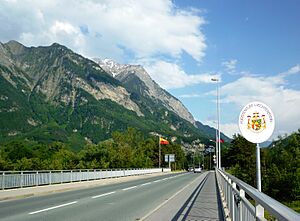
The government of Liechtenstein collects taxes on personal income, business income, and wealth. The basic personal income tax rate is low. When combined with local taxes, the total income tax rate is around 17.82%. There's also a social security tax for employees. The tax on wealth is also low. The tax rate for company profits is 12.5%.
In the past, Liechtenstein was known as a place where very wealthy people and businesses could keep their money to avoid taxes in their home countries. This was often done through special financial setups called "foundations."
However, in recent years, Liechtenstein has worked hard to become a more open and legitimate financial center. It has made efforts to stop illegal money activities. In 2009, a group called the Organisation for Economic Co-operation and Development removed Liechtenstein from its list of uncooperative tax havens. In 2015, Liechtenstein and the European Union signed an agreement to automatically share financial information for tax purposes. This shows Liechtenstein's commitment to being transparent with other European countries.
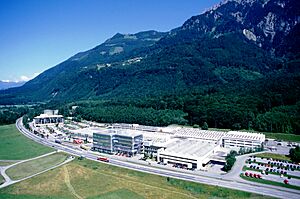
Welcoming Visitors
Tourism is a big part of Liechtenstein's economy. In 2021, nearly 80,000 tourists visited the country. Between 2009 and 2021, the number of tourists usually ranged from 60,000 to 100,000 each year. People come to enjoy the beautiful Alpine scenery and winter sports.
Government and Politics


Liechtenstein has a unique political system. It mixes parts of an absolute monarchy (where the monarch has a lot of power), a representative democracy (where people elect representatives), and a direct democracy (where citizens can vote directly on laws). The monarch, the Prince, has significant power in the government. He is the only European monarch who still plays such an active role in the country's daily politics.
The Prince is the head of state and represents Liechtenstein in its dealings with other countries. However, Switzerland handles many of Liechtenstein's diplomatic relations. The current Constitution of Liechtenstein was approved in 2003. It gives the Prince strong powers, including the ability to stop laws, remove the government, and rule by emergency orders.
The main law-making body is the Landtag, which is like a parliament. It has 25 members who are elected for up to four years. Fifteen members come from the "Upper Country" (Oberland) and ten from the "Lower Country" (Unterland). Political parties must get at least 8% of the national vote to win seats in parliament. The parliament suggests and approves the government, which the Prince then officially appoints.
The government includes the head of government (the prime minister) and four other ministers. They are chosen by the Prince based on the parliament's suggestions. At least two government members must come from each of the two regions (Oberland and Unterland). The government members are responsible to the parliament. The parliament can ask the Prince to remove a minister or the entire government. The Prince can also do this on his own.
Liechtenstein's courts include the Regional Court, the Princely High Court of Appeal, the Princely Supreme Court, the Administrative Court, and the State Court. The State Court checks if laws follow the constitution.
Geography and Climate
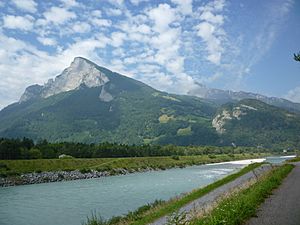
Liechtenstein is located in the Upper Rhine valley, within the European Alps. It shares borders with Austria to the east and Switzerland to the south and west. The Rhine River forms the entire western border. From south to north, the country is about 24 kilometers long. In 1943, an inland canal was built to connect to the Rhine.
The highest point in Liechtenstein is Grauspitz, which is 2,599 meters high. Even though it's in the Alps, the climate is quite mild because of warm southerly winds. In winter, the mountain slopes are great for winter sports. Recent surveys show that Liechtenstein's area is 160 square kilometers, and its borders are 77.9 kilometers long. This is slightly longer than previously thought.
Liechtenstein is one of only two doubly landlocked countries in the world. This means it's completely surrounded by countries that are also landlocked. The other is Uzbekistan. Liechtenstein is the sixth-smallest sovereign state in the world by area.
The country is divided into 11 areas called municipalities (Gemeinden). Most municipalities are just one town or village. Five of them are in the "Lower Country" (Unterland), and the other six are in the "Upper Country" (Oberland).
Weather in Liechtenstein

Despite being in the Alps, Liechtenstein has a relatively mild climate. This is thanks to warm, dry winds called "foehn" winds. These winds make spring and autumn longer and can even bring temperatures around 15°C in winter. The mountains of Switzerland and Austria protect Liechtenstein from cold air.
In winter, temperatures rarely drop below -15°C. In summer, average temperatures are between 20°C and 28°C. The country gets about 900 to 1200 millimeters of rain each year, but in the high mountains, it can be up to 1900 millimeters. Liechtenstein gets about 1600 hours of sunshine per year.
Rivers, Lakes, and Mountains
The Rhine is the longest and largest river in Liechtenstein, about 27 kilometers long. It forms the natural border with Switzerland and is important for water supply and recreation. The Samina River is the second longest, about 10 kilometers long. It flows into Austria.
The only natural lake in Liechtenstein is the Gampriner Seelein. It was formed in 1927 by a flood from the Rhine. There are also artificial lakes, mainly used to make electricity. The Steg Reservoir is the largest lake in Liechtenstein.
About half of Liechtenstein is mountainous. The country is part of the Rhaetikon mountain range. The highest point is the Vordere Grauspitz, at 2,599 meters above sea level. The lowest point is the Ruggeller Riet, at 430 meters above sea level.
Liechtenstein has 32 mountains that are at least 2,000 meters high. The Falknishorn is the fifth highest mountain and marks the southernmost point of the country. The Naafkopf mountain is where the borders of Liechtenstein, Graubünden (Switzerland), and Vorarlberg (Austria) meet.
People and Languages
With a population of about 39,315 people (as of 2021), Liechtenstein is Europe's fourth-smallest country. Most of its people speak a German dialect called Alemannic. However, about one-third of the population was born in other countries. These include German speakers from Germany, Austria, and Switzerland, as well as Italians and Turks. People born outside Liechtenstein make up two-thirds of the country's workers.
Liechtensteiners live long lives, with an average life expectancy of 82 years. For males, it's 79.8 years, and for females, it's 84.8 years (2018). The infant mortality rate is very low, at 4.2 deaths per 1,000 live births (2018).
Speaking in Liechtenstein
The official language is German, spoken by 92% of the people as their main language in 2020. About 73% of Liechtenstein's population speak an Alemannic dialect at home. This dialect is quite different from standard German but is similar to dialects spoken in nearby Switzerland and Austria. In the village of Triesenberg, people speak a special Walser German dialect. Most Liechtensteiners also understand and speak Swiss Standard German.
Faith in Liechtenstein
According to Liechtenstein's Constitution, Catholicism is the official state religion. The government protects all religions and considers people's "religious interests" important. In schools, religious education in Catholicism or Protestantism is usually required, though exceptions are allowed. Religious groups also receive tax benefits from the government.
In 2010, 85.8% of the population were Christian. Of these, 75.9% were Catholic, and 9.6% were other Christians (Protestant or Orthodox). The largest minority religion is Islam, followed by 5.4% of the population.
Learning and Education
Everyone in Liechtenstein can read and write; the literacy rate is 100%. A 2006 report ranked Liechtenstein's education system as the 10th-best in the world. In 2012, Liechtenstein had the highest scores of any European country in the PISA tests, which measure student performance.
Liechtenstein has four main centers for higher education:
- University of Liechtenstein
- Private University in the Principality of Liechtenstein
- Liechtenstein Institute
- International Academy of Philosophy, Liechtenstein
There are also nine public high schools in the country, including the Liechtensteinisches Gymnasium in Vaduz.
Getting Around Liechtenstein
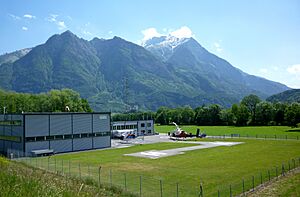
Roads and Buses
Liechtenstein has about 250 kilometers of paved roads and 90 kilometers of marked bicycle paths. The Liechtenstein Bus system connects to the Swiss bus and train networks. If you have a Swiss Travel Pass, you can ride Liechtenstein's buses for free.
Train Travel
Liechtenstein has a single railway line that is 9.5 kilometers long. It connects Feldkirch in Austria with Buchs in Switzerland. There are four train stations in Liechtenstein: Schaan-Vaduz, Forst Hilti, Nendeln, and Schaanwald. Regional trains run between Feldkirch and Buchs on weekdays. Long-distance trains do not stop in Liechtenstein.
Air Travel
Liechtenstein is one of the few countries without an airport. The closest large airport is Zurich Airport in Switzerland, about 130 kilometers away. The nearest small airport is St. Gallen–Altenrhein Airport, about 50 kilometers away. Balzers Heliport is available for helicopter flights.
Culture and Arts
Because Liechtenstein is small, its culture has been greatly influenced by nearby German-speaking regions like Austria, Switzerland, and parts of Germany.
The largest museum is the Kunstmuseum Liechtenstein, which displays modern and contemporary art from around the world. The building itself is a famous landmark in Vaduz. The Liechtenstein National Museum shows permanent exhibits on the country's culture and nature, as well as special exhibits. There is also a stamp museum, a ski museum, and a museum about rural life from 500 years ago.
The Liechtenstein State Library collects all books published in the country. Famous historical sites include Vaduz Castle, Gutenberg Castle, and Vaduz Cathedral. The Prince of Liechtenstein has one of the world's best private art collections, which is shown at the Liechtenstein Museum in Vienna.
On the country's national holiday, everyone is invited to the Prince's castle for a celebration with speeches and free beer. Music and theater are also important. There are many music groups and two main theaters.
Media and Communication
The main internet and mobile phone company in Liechtenstein is Telecom Liechtenstein. The country has two television channels. 1FLTV is a private channel. The Landeskanal (National Channel) is run by the government and shows government meetings, public programs, and cultural events. Both are available on local cable.
Radio Liechtenstein is the country's only local radio station. Liechtenstein also has one main newspaper, Liechtensteiner Vaterland.
Sports and Achievements
Liechtenstein's football (soccer) teams play in the Swiss leagues. The Liechtenstein Football Cup allows one team each year to play in the UEFA Europa Conference League. FC Vaduz is the most successful team in the Cup.
The Liechtenstein national football team is often seen as an easy opponent. However, in 2004, they had a surprising 2-2 draw with Portugal. A few days later, they beat Luxembourg 4-0 in a World Cup qualifying match. In 2007, they beat Latvia 1-0 and Iceland 3-0.
As an alpine country, Liechtensteiners are very good at winter sports, especially downhill skiing. The country's only ski area is Malbun. Hanni Wenzel won two gold medals and one silver medal at the 1980 Winter Olympics. Her brother Andreas won a silver and a bronze medal. Her daughter Tina Weirather won a bronze medal in 2018. Liechtenstein has won more Olympic medals per person than any other country, all in alpine skiing. It is the smallest country to win an Olympic medal and the only one to win medals only at the Winter Games.
Motorsport is also popular. Rikky von Opel raced in Formula One for Liechtenstein in the 1970s. Manfred Schurti competed in the 24 Hours of Le Mans race many times. Today, Fabienne Wohlwend and Matthias Kaiser represent the country in endurance racing.
Other successful athletes from Liechtenstein include tennis players Stephanie Vogt and Kathinka von Deichmann, and swimmers Julia Hassler and Christoph Meier.
In March 2020, a world record for electric motorcycles was set in Liechtenstein. Artist Michel von Tell rode over 1,000 miles in 24 hours on an electric Harley-Davidson.
See also
 In Spanish: Liechtenstein para niños
In Spanish: Liechtenstein para niños







